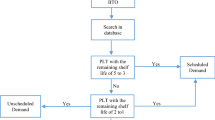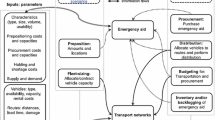Abstract
Production planning in the blood supply chain is a challenging task. Many complex factors such as uncertain supply and demand, blood group proportions, shelf life constraints and different collection and production methods have to be taken into account, and thus advanced methodologies are required for decision making. This paper presents an integrated simulation-optimization model to support both strategic and operational decisions in production planning. Discrete-event simulation is used to represent the flows through the supply chain, incorporating collection, production, storing and distribution. On the other hand, an integer linear optimization model running over a rolling planning horizon is used to support daily decisions, such as the required number of donors, collection methods and production planning. This approach is evaluated using real data from a blood center in Colombia. The results show that, using the proposed model, key indicators such as shortages, outdated units, donors required and cost are improved.



Similar content being viewed by others
References
WHO (2014) Blood safety and availability. World Health Organization. http://www.who.int/mediacentre/factsheets/fs279/en/. Accessed 1 April 2014
Osorio AF, Brailsford SC, Smith HK (2015) A structured review of quantitative models in the blood supply chain: a taxonomic framework for decision-making. Int J Prod Res. doi:10.1080/00207543.2015.1005766, 1–22
Pratt ML, Grindon AJ (1982) Computer simulation analysis of blood donor queueing problems. Transfusion 22(3):234–237. doi:10.1046/j.1537-2995.1982.22382224948.x
Brennan JE, Golden BL, Rappoport HK (1992) Go with the flow - improving Red Cross bloodmobiles using simulation analysis. Interfaces 22(5):1–13. doi:10.1287/inte.22.5.1
Michaels JD, Brennan JE, Golden BL, Fu MC (1993) A simulation study of donor scheduling systems for the American Red Cross. Comput Oper Res 20(2):199–213. doi:10.1016/0305-0548(93)90075-T
Lowalekar H, Ravichandran N (2010) Model for blood collections management. Transfusion 50(12 pt 2):2778–2784
Alfonso E, Xie XL, Augusto V, Garraud O (2013) Modelling and simulation of blood collection systems: improvement of human resources allocation for better cost-effectiveness and reduction of candidate donor abandonment. Vox Sang 104(3):225–233. doi:10.1111/vox.12001
Alfonso E, Xie XL, Augusto V, Garraud O (2012) Modeling and simulation of blood collection systems. Health Care Manag Sci 15(1):63–78. doi:10.1007/s10729-011-9181-8
Alfonso VA, Xie X (2013) Tactical planning of bloodmobile collection systems. In: 2013 I.E. International Conference on Automation Science and Engineering (CASE), Madison, WI, 17–20 August 2013. pp 26–31
Alfonso E, Augusto V, Xie X (2014) Mathematical programming models for annual and weekly bloodmobile collection planning. IEEE Trans Autom Sci Eng 99:1–10. doi:10.1109/TASE.2014.2329571
Madden E, Murphy L, Custer B (2007) Modeling red cell procurement with both double-red-cell and whole-blood collection and the impact of European travel deferral on units available for transfusion. Transfusion 47(11):2025–2037
Ghandforoush P, Sen TK (2010) A DSS to manage platelet production supply chain for regional blood centers. Decis Support Syst 50(1):32–42. doi:10.1016/j.dss.2010.06.005
Gunpinar S (2013) Supply chain optimization of blood products. PhD dissertation, University of South Florida, Tampa, FL
Glynn SA, Busch MP, Schreiber GB, Murphy EL, Wright DJ, Tu Y, Kleinman SH (2003) Effect of a national disaster on blood supply and safety: the September 11 experience. JAMA 289(17):2246–2253. doi:10.1001/jama.289.17.2246
Sonmezoglu M, Kocak N, Oncul O, Ozbayburtlu S, Hepgul Z, Kosan E, Aksu Y, Bayik M (2005) Effects of a major earthquake on blood donor types and infectious diseases marker rates. Transfus Med 15(2):93–97. doi:10.1111/j.0958-7578.2005.00557.x
Boppana RV, Chalasani S (2007) Analytical models to determine desirable blood acquisition rates. Paper presented at the 2007 I.E. International Conference on System of Systems Engineering, San Antonio, TX, 16–18 April 2007
Jabbarzadeh A, Fahimnia B, Seuring S (2014) Dynamic supply chain network design for the supply of blood in disasters: a robust model with real world application. Transp Res E Logist Transp Rev 70(0):225–244. doi:10.1016/j.tre.2014.06.003
Deuermeyer B, Pierskalla WP (1978) A by-product production system with an alternative. Manag Sci 24(13):1373–1383
Deuermeyer B (1979) A multi-type production system for perishable inventories. Oper Res 27(5):935–943
Sirelson V, Brodheim E (1991) A computer planning model for blood platelet production and distribution. Comput Methods Prog Biomed 35(4):279–291. doi:10.1016/0169-2607(91)90006-F
Katz AJ, Carter CW, Saxton P, Blutt J, Kakaiya RM (1983) Simulation analysis of platelet production and inventory management. Vox Sang 44(1):31–36
Ledman RE, Groh N (1984) Platelet production planning to ensure availability while minimizing outdating. Transfusion 24(6):532–533. doi:10.1046/j.1537-2995.1984.24685066819.x
Haijema R, van der Wal J, van Dijk NM (2007) Blood platelet production: optimization by dynamic programming and simulation. Comput Oper Res 34(3):760–779
Haijema R, van Dijk N, van der Wal J, Smit Sibinga C (2009) Blood platelet production with breaks: optimization by SDP and simulation. Int J Prod Econ 121(2):464–473. doi:10.1016/j.ijpe.2006.11.026
van Dijk N, Haijema R, van der Wal J, Sibinga CS (2009) Blood platelet production: a novel approach for practical optimization. Transfusion 49(3):411–420. doi:10.1111/j.1537-2995.2008.01996.x
Baesler F, Martinez C, Yaksic E, Herrera C (2011) Logistic and production process in a regional blood center: modeling and analysis. Rev Med Chile 139(9):1150–1156
Page B (1980) Alternative inventory and distribution policies for a regional blood banking system. Methods Inf Med 19(2):83–87
Rytilä JS, Spens KM (2006) Using simulation to increase efficiency in blood supply chains. Manag Res News 29(12):801–819
Katsaliaki K, Brailsford SC (2007) Using simulation to improve the blood supply chain. J Oper Res Soc 58(2):219–227
Yegül M (2007) Simulation analysis of the blood supply chain and a case study. Master’s thesis, Middle East Technical University, Ankara
Baesler F, Nemeth M, Martínez C, Bastías A (2013) Analysis of inventory strategies for blood components in a regional blood center using process simulation. Transfusion. doi:10.1111/trf.12287
Lowalekar H, Ravichandran N (2011) A model for blood components processing. Transfusion 51(7 pt 2):1624–1634
Simonetti A, Forshee R, Anderson S, Walderhaug M (2013) A stock-and-flow simulation model of the US blood supply. Transfusion. doi:10.1111/trf.12392
Nagurney A, Masoumi A, Yu M (2012) Supply chain network operations management of a blood banking system with cost and risk minimization. Comput Manag Sci 9(2):205–231. doi:10.1007/s10287-011-0133-z
Nagurney A, Masoumi A (2012) Supply chain network design of a sustainable blood banking system. In: Boone T, Jayaraman V, Ganeshan R (eds) Sustainable supply chains, vol 174, International series in operations research & management science. Springer, New York, pp 49–72. doi:10.1007/978-1-4419-6105-1_5
Abdulwahab U, Wahab MIM (2014) Approximate dynamic programming modeling for a typical blood platelet bank. Comput Ind Eng 78:259–270. doi:10.1016/j.cie.2014.07.017
Lang JC (2010) Blood bank inventory control with transshipments and substitutions. In: Günter F, Walter T (eds) Production and inventory management with substitutions, vol 636, Lecture notes in economics and mathematical systems. Springer, Berlin, Heidelberg, pp 205–226
Nikolopoulou A, Ierapetritou MG (2012) Hybrid simulation based optimization approach for supply chain management. Comput Chem Eng 47:183–193
Santoso T, Ahmed S, Goetschalckx M, Shapiro A (2005) A stochastic programming approach for supply chain network design under uncertainty. Eur J Oper Res 167(1):96–115
Almeder C, Preusser M, Hartl R (2009) Simulation and optimization of supply chains: alternative or complementary approaches? OR Spectr 31(1):95–119. doi:10.1007/s00291-007-0118-z
Figueira G, Almada-Lobo B (2014) Hybrid simulation-optimization methods: a taxonomy and discussion. Simul Model Pract Theory 46:118–134. doi:10.1016/j.simpat.2014.03.007
INS (2013) Informe Nacional de Indicadores 2013 (national report of indicators). Gestión y Supervisión Red bancos de sangre. Instituto Nacional de Salud, Bogotá
Woodget M (2014) Annual functional report – estates & facilities. NHS Blood and Transplant. http://www.nhsbt.nhs.uk/download/board_papers/jan14/annual_functional_report_estates_and_facilities.pdf. Accessed 28 Sept 2015
Acknowledgments
We are very grateful to the staff of the Hemocentro Distrital for their support with this project and for providing data. We are also grateful for the comments of the editor and anonymous reviewers, which have greatly improved the quality of this paper. The first author’s research is funded by a PhD scholarship from the Departamento Administrativo de Ciencia y Tecnologia, Colciencias, Bogota, Colombia.
Author information
Authors and Affiliations
Corresponding author
Rights and permissions
About this article
Cite this article
Osorio, A.F., Brailsford, S.C., Smith, H.K. et al. Simulation-optimization model for production planning in the blood supply chain. Health Care Manag Sci 20, 548–564 (2017). https://doi.org/10.1007/s10729-016-9370-6
Received:
Accepted:
Published:
Issue Date:
DOI: https://doi.org/10.1007/s10729-016-9370-6




